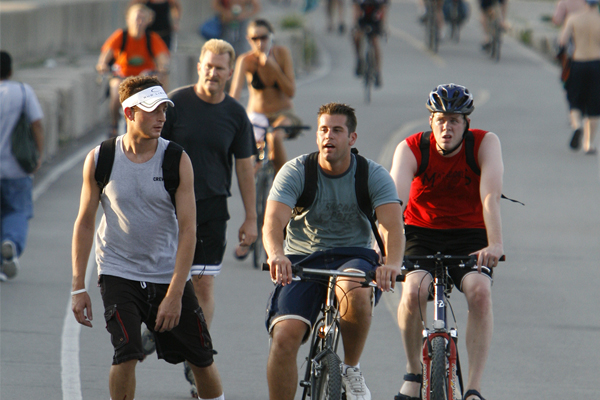
Photo: Michael Tercha / Chicago Tribune
Chicagoans tend to think we can engineer our way out of problems. Aspects of our history support that idea. The problem of the sewage-filled Chicago River flowing into Lake Michigan, whence we get our drinking water, was solved by engineering. Reverse the flow of the River—problem solved.
Now, the city and state are looking into rebuilding the north section of Lake Shore Drive, and perhaps aspects of the landfill parkland to its east. According to reports in both the Sun-Times and the Tribune, users of the parkland who participated in public meetings are anxious to engineer a solution to another problem of flow: Conflict between different users of the Lakefront Trail.
One widely supported plan is to create two separate paths: One for bicyclists and one for pedestrians. (Some people consider "slow" bikers to be at pedestrian speed; for the sake of this post, I’m thinking cyclists en toto v. pedestrians.)
At first glance, this seems like a great idea—Lycra-clad cyclists get to zoom along in their own space and at their own pace, while runners and walkers can amble on foot safely on their own pavement.
But a few moments' thought raise some questions about how well this would work.
First, where do skateboarders and rollerbladers go? Something tells me that runners will say on the bike path (They have wheels!) and bikers will say on the footpath (They are not riding bikes!). A third path for these folks seems a bit extreme. Or how about a third and a fourth path? Can skatefolk and bladers really get along?
Let’s stick with just two paths and sort out these sorts of sub-questions later.
More vitally: How will the different uses of the two lanes be enforced? What would stop pedestrians from walking on the bike path, or bikers from riding among the walkers? Signage would help, of course, but that’s not enforcement.
Conflict on the Lakefront Trail, and in other Chicago spaces from sidewalks to the El, comes not from the way the space is engineered or signed, but from the way people behave despite engineering and signage.
To cite just a few examples familiar to anyone who uses our parks regularly:
- The path clearly has two clearly marked lanes, northbound and southbound. Yet large groups of people routinely walk six or more abreast, blocking the path in both directions, not infrequently responding to “On your left” with obscenities and threats of violence.
- Bikers stop mid-path to chat or fix flats or talk on their cell phones.
- People with earbuds surgically implanted in their heads don’t hear anything but their music.
- Parents ignore their toddlers toddling into the path of cyclists and runners.
- Dog-walkers let their extendable leashes extend entirely across the path.
- People checking their smartphones do dumb things like turning 90 degrees to their left without looking first.
Such behaviors don’t just lead to conflicts between bikers and pedestrians. In more than 30 years of riding the Lakefront Trail, I’ve seen collisions between just about every combination of person/vehicle short of a motorized wheelchair and pogo stick.
It’s not the path that needs engineering, it’s human behavior. Good luck with that.
Even radical physical solutions would fall before human nature. And even if the bikers and walkers were on separate paths, walking paths going east-west would still intersect with the bikers’ high-speed zone, obviating any improvements separation might offer.
But perhaps that Chicago “City Beautiful” idealism might work here: You want to separate those reckless cyclists from the rest of the users of the path, the ghost of Apocryphal Daniel Burnham tells us to Make No Little Plans.
Here's my idea:
Elevate the bike path and make those crossings pedestrian viaducts. The city is already planning to spend $44.5 million on the Navy Pier Flyover (despite a much cheaper alternative plan). Let’s spend $150 million for a Velo-Flyway (copyright/trademark/patent-pending) from Ardmore to 57th Street, with on and off-ramps every half mile or so. Hell, extend it out over the Lake to Howard and South Works—it might be a bit icy in winter, but we must think big. Such an engineering solution would separate cyclists and pedestrians forever. Problem solved.
But human nature guarantees that, even if such a thing were built, pedestrians would ignore Bikes Only signage and go up to check out the view. Other knuckleheads would set up picnics at the bottom of off-ramps, and be outraged when cyclists flew down through their potato salad and hot dogs.
And some cyclists—acrophobes?—would ride along the ground-level pedestrians-only path nonetheless.
The real conflict is not between two wheels and two feet, it’s between two types of people: People who are observant and considerate of others, and people who are oblivious and/or rude. You can find both sorts walking or riding, and no rebuild of the Lakefront Trail will change that basic reality of human nature and Chicago life.


